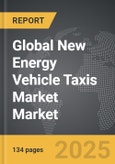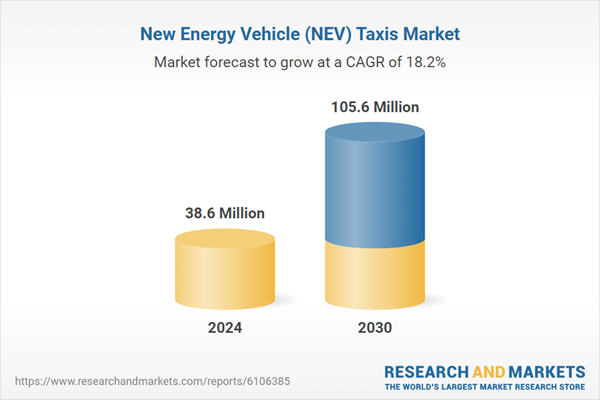Global New Energy Vehicle (NEV) Taxis Market - Key Trends & Drivers Summarized
How Are Emission Mandates Accelerating NEV Taxi Deployment?
Stricter emission regulations across major cities have intensified efforts to shift urban transportation toward cleaner alternatives. As part of broader climate goals, municipal governments are prioritizing electrification of taxi fleets to reduce carbon output and urban pollution. New Energy Vehicle (NEV) taxis, including battery electric, plug-in hybrid, and hydrogen-powered variants, are being integrated into city-level public mobility strategies. Operators are responding to mandates and incentives by replacing aging internal combustion engine taxis with zero-emission or low-emission alternatives.Supportive policies, such as tax exemptions, registration privileges, and purchase subsidies, are easing the transition for taxi owners and fleet operators. In many urban centers, NEV taxis are being prioritized for operating permits or given access to designated green lanes. This regulatory support, combined with rising consumer preference for sustainable ride-hailing options, is helping to scale adoption across both government-backed fleets and private mobility platforms.
What Role Do Technologies and Infrastructure Play in Supporting NEV Fleets?
Advances in battery technology, especially in energy density and charge speed, have made NEV taxis more practical for continuous operation. Many cities are developing fast-charging and battery-swapping stations to support taxi fleets with minimal downtime. These infrastructure developments are essential for maintaining service efficiency in high-demand zones, where taxi availability and turnaround time are critical to fleet profitability.Technology is also reshaping fleet operations. AI-powered route optimization, smart dispatching, and integrated telematics are improving vehicle utilization and passenger wait times. Fleet managers are leveraging software platforms to monitor battery health, schedule recharges, and minimize energy costs. In parallel, the introduction of semi-autonomous safety features and real-time diagnostics is reducing risk and improving operational consistency across NEV taxi services.
How Are Business Models Adapting to the NEV Taxi Ecosystem?
Ownership and operational models in the NEV taxi market are diversifying to align with regional conditions. In several countries, ride-hailing companies are adopting fleet-leasing or asset-light models to expand NEV presence without large capital investments. Operators lease vehicles directly to drivers or manage centralized fleets supported by integrated charging logistics. This approach allows quicker scalability and reduced operational friction for drivers.In dense city centers, compact NEV models with modest range are preferred for intracity travel, offering efficiency in traffic and ease of charging. In suburban or regional zones, plug-in hybrid and extended-range electric taxis are still deployed where infrastructure coverage is limited. Vehicle selection also depends on regional regulatory thresholds for emissions and fuel standards. Localized adaptation of fleet composition and service models reflects how the NEV taxi market is evolving differently across geographies.
Growth in the NEV taxi market is driven by several factors.
Expanding regulatory pressure to reduce vehicle emissions is compelling taxi operators to adopt cleaner vehicle technologies. Financial incentives and subsidies are reducing the cost burden of NEV adoption for both individual drivers and large fleet owners. Advances in battery efficiency and the rollout of fast-charging or battery-swapping stations are enabling continuous taxi operations. Digital fleet management tools and AI-enabled mobility platforms are improving operational visibility and profitability. Urban infrastructure planning is increasingly favoring electric vehicle adoption through charging networks and emission-restricted zones. Growing environmental awareness and consumer preference for eco-friendly mobility services are also contributing to increased demand for NEV taxis.Report Scope
The report analyzes the New Energy Vehicle (NEV) Taxis market, presented in terms of market value (US$). The analysis covers the key segments and geographic regions outlined below:- Segments: Type (Battery Electric Vehicles, Hybrid Vehicles, Plug-in Hybrid Electric Vehicles); End-Use (Passenger Cars End-Use, Commercial Vehicles End-Use).
- Geographic Regions/Countries: World; United States; Canada; Japan; China; Europe (France; Germany; Italy; United Kingdom; and Rest of Europe); Asia-Pacific; Rest of World.
Key Insights:
- Market Growth: Understand the significant growth trajectory of the Battery Electric Vehicles segment, which is expected to reach US$57.9 Million by 2030 with a CAGR of a 16.9%. The Hybrid Vehicles segment is also set to grow at 19.7% CAGR over the analysis period.
- Regional Analysis: Gain insights into the U.S. market, valued at $10.2 Million in 2024, and China, forecasted to grow at an impressive 17.3% CAGR to reach $16.3 Million by 2030. Discover growth trends in other key regions, including Japan, Canada, Germany, and the Asia-Pacific.
Why You Should Buy This Report:
- Detailed Market Analysis: Access a thorough analysis of the Global New Energy Vehicle (NEV) Taxis Market, covering all major geographic regions and market segments.
- Competitive Insights: Get an overview of the competitive landscape, including the market presence of major players across different geographies.
- Future Trends and Drivers: Understand the key trends and drivers shaping the future of the Global New Energy Vehicle (NEV) Taxis Market.
- Actionable Insights: Benefit from actionable insights that can help you identify new revenue opportunities and make strategic business decisions.
Key Questions Answered:
- How is the Global New Energy Vehicle (NEV) Taxis Market expected to evolve by 2030?
- What are the main drivers and restraints affecting the market?
- Which market segments will grow the most over the forecast period?
- How will market shares for different regions and segments change by 2030?
- Who are the leading players in the market, and what are their prospects?
Report Features:
- Comprehensive Market Data: Independent analysis of annual sales and market forecasts in US$ Million from 2024 to 2030.
- In-Depth Regional Analysis: Detailed insights into key markets, including the U.S., China, Japan, Canada, Europe, Asia-Pacific, Latin America, Middle East, and Africa.
- Company Profiles: Coverage of players such as Alimentiv Inc., Axon CRO, Atlantic Research Group, Inc., Charles River Laboratories, CTI Clinical Trial & Consulting and more.
- Complimentary Updates: Receive free report updates for one year to keep you informed of the latest market developments.
Some of the 36 companies featured in this New Energy Vehicle (NEV) Taxis market report include:
- AB Volvo
- Anhui Jianghuai Automobile (JAC Motors)
- BAIC Group (Beijing Automotive Industry Co.)
- BMW AG
- BYD Auto Co. Ltd.
- Changan Automobile Co., Ltd.
- Daimler AG
- Dongfeng Motor Corporation
- Ford Motor Company
- General Motors Company
- Honda Motor Co., Ltd.
- Hyundai Motor Company
- JAC Motors
- London Electric Vehicle Company
- Mahindra & Mahindra Ltd.
- Nissan Motor Corporation
- Tesla, Inc.
- Tata Motors
- Toyota Motor Corporation
- Volkswagen Group
This edition integrates the latest global trade and economic shifts into comprehensive market analysis. Key updates include:
- Tariff and Trade Impact: Insights into global tariff negotiations across 180+ countries, with analysis of supply chain turbulence, sourcing disruptions, and geographic realignment. Special focus on 2025 as a pivotal year for trade tensions, including updated perspectives on the Trump-era tariffs.
- Adjusted Forecasts and Analytics: Revised global and regional market forecasts through 2030, incorporating tariff effects, economic uncertainty, and structural changes in globalization. Includes historical analysis from 2015 to 2023.
- Strategic Market Dynamics: Evaluation of revised market prospects, regional outlooks, and key economic indicators such as population and urbanization trends.
- Innovation & Technology Trends: Latest developments in product and process innovation, emerging technologies, and key industry drivers shaping the competitive landscape.
- Competitive Intelligence: Updated global market share estimates for 2025, competitive positioning of major players (Strong/Active/Niche/Trivial), and refined focus on leading global brands and core players.
- Expert Insight & Commentary: Strategic analysis from economists, trade experts, and domain specialists to contextualize market shifts and identify emerging opportunities.
Table of Contents
Companies Mentioned (Partial List)
A selection of companies mentioned in this report includes, but is not limited to:
- AB Volvo
- Anhui Jianghuai Automobile (JAC Motors)
- BAIC Group (Beijing Automotive Industry Co.)
- BMW AG
- BYD Auto Co. Ltd.
- Changan Automobile Co., Ltd.
- Daimler AG
- Dongfeng Motor Corporation
- Ford Motor Company
- General Motors Company
- Honda Motor Co., Ltd.
- Hyundai Motor Company
- JAC Motors
- London Electric Vehicle Company
- Mahindra & Mahindra Ltd.
- Nissan Motor Corporation
- Tesla, Inc.
- Tata Motors
- Toyota Motor Corporation
- Volkswagen Group
Table Information
| Report Attribute | Details |
|---|---|
| No. of Pages | 134 |
| Published | December 2025 |
| Forecast Period | 2024 - 2030 |
| Estimated Market Value ( USD | $ 38.6 Million |
| Forecasted Market Value ( USD | $ 105.6 Million |
| Compound Annual Growth Rate | 18.2% |
| Regions Covered | Global |









